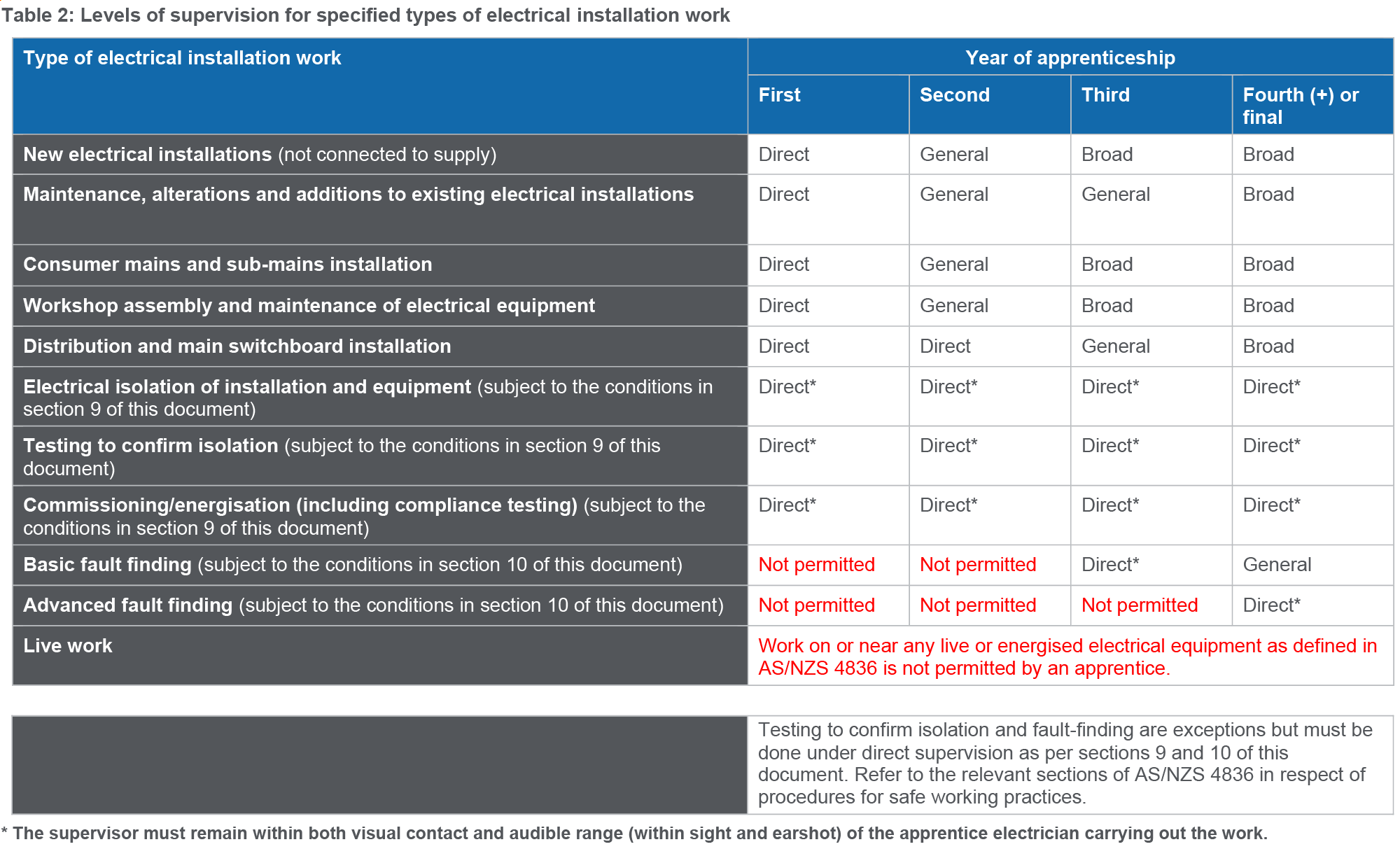Effective from 1 September 2025, an amended version of the Requirements for the Effective Supervision of Electrical Apprentices (the Requirements) will come into force. All Victorian electrical business owners, supervisors, and apprentices must comply.
Key Changes
The amended Requirements, released by Energy Safe Victoria (ESV), include the following updates:
- Supervision Ratios Tightened: Stricter limits have been introduced on how many apprentices a supervisor can oversee.
- Clarification on Scope: Emphasis that supervision ratios apply only to electrical installation work. Routine tasks such as moving equipment or trench digging are excluded.
- Direct Supervision Levels Defined by Risk:
- High-risk tasks require direct visual and audible supervision.
- Lower-risk tasks can be directly supervised within audible or visual supervision.
- Refer to Requirements for the effective supervision of apprentice electricians | Energy Safe Victoria for further clarification on what direct supervision tasks are classified as high and low risk tasks.
- Supervisor Competency: Retained that supervisors must be competent in the specific work being undertaken by the apprentice (i.e. a supervisor overseeing an apprentice installing solar panels must have expertise in installing solar panels)
- Access to the Requirements: Employers must ensure all supervisors have access to either a digital or printed copy of the Requirements.
- Training Contracts: Employers must confirm that each apprentice has a valid training contract in place.
Apprentice Empowerment
Importantly, the revised Requirements formally recognise the role and responsibilities of electrical apprentices. In particular, apprentices have the right to refuse work if they have reasonable concerns about the adequacy of their supervision.
Updated Supervision Ratios
See the Table 1 below for a comparison between the current supervision ratios and the new ratios effective from 1 September 2025:
Table 1: Supervisor: Apprentice Ratio Levels
Key x : x = Supervisor : Apprentice Ratio
| Supervision Level | Current | As of 1 September 2025 |
| Direct | 1:2 | 1:1 |
| General | 1:4 | 1:3 |
| Broad | N/A | 1:5 |
| Combination: Direct & General | N/A | 1:1 Direct + 1 General |
| Combination: Direct & Broad | N/A | 1:1 Direct + 3 Broad |
| Combination: General & Broad | N/A | 1:1 General + 3 Broad |
ESV has emphasised these ratios are only applicable to electrical installation work, and they may demonstrate tasks to multiple apprentices at once and make use of peer observation.
Moving up Supervision Levels
As already in place, the revised version adopts a model based on both time and competency.
Refer to Table 2 for the minimum requirements for an apprentice being supervised at each level. It is the responsibility of the supervisor to assess whether the apprentice is also competent to progress to the next level of supervision, in addition to meeting the minimum time requirement.
Table 2: Levels of supervision for specified types of electrical installation work

Fault-finding has now been split into two categories: basic and advanced.
- 1st and 2nd-year apprentices remain prohibited from performing any fault-finding tasks, regardless of supervision.
- 3rd-year apprentices are not permitted to perform advanced fault-finding, even under supervision.
- Basic fault-finding may be performed by 3rd-year apprentices but only under direct supervision, with both audible and visual proximity.
- 4th year apprentices are permitted to perform both fault finding tasks under direct supervision, with both audible and visual proximity.
MEA Advocacy on Supervision Amendments – What We Fought For and What Was Achieved
Since early 2024, MEA has been actively engaged with ESV on the upcoming amendments to supervision requirements for electrical apprentices. We made it clear that MEA does not support tighter supervision ratios. Instead, we advocated for a competency-based framework, similar to Queensland’s model, which allows supervisors the flexibility to assess apprentices primarily based on their capabilities, rather than being restricted by the amount of time the apprentice has spent in training.
What We Advocated For
We noted the following concerns in our advocacy:
- Tighter ratios could make it even harder to address the current skills shortage.
- Due to limited resources, small electrical contractors may find it difficult to hire the number of first-year apprentices they would typically employ, as they cannot afford to hire the necessary number of fully qualified electricians to meet the tighter supervision ratio requirements.
MEA strongly opposed the tightening of supervision ratios and advocated instead for:
- A greater focus on training supervisors, to avoid the rise of “accidental supervisors” without proper preparation.
- A system that does not disadvantage small businesses, which often lack the resources to meet rigid ratio requirements.
After reviewing our concerns, ESV concluded:
- Most small businesses are unlikely to be significantly impacted by the new ratios based on current apprentice enrolment trends.
- Tighter supervision may actually improve apprenticeship completion rates, as apprentices gain more meaningful supervision and experience.
They also responded to our request for a cost-benefit analysis, noting that while a quantitative assessment was not conducted, their investigations found costs to small businesses will be minimal.
Future Opportunities in the Supervision Space
MEA called for the development of a competency guideline to assist supervisors and PCBUs in making informed decisions about when apprentices are ready to progress to relaxed levels of supervision (in addition to table 1 being complied with). While this guideline has not been drafted, ESV has acknowledged the value of this recommendation and are open to progressing it further.
Time to Prepare
We encourage all Victorian members to review the amended supervision requirements and begin preparing to meet their obligations ahead of the upcoming implementation date.




